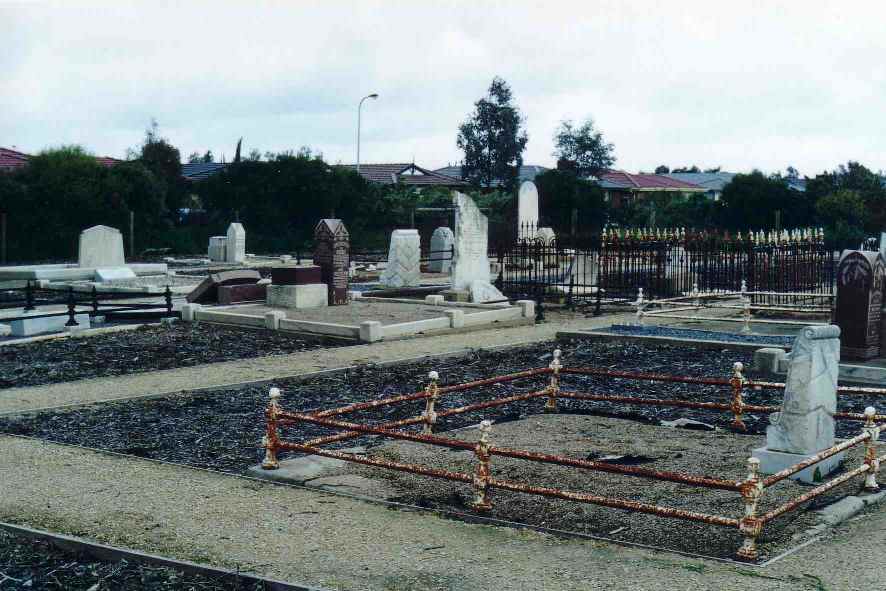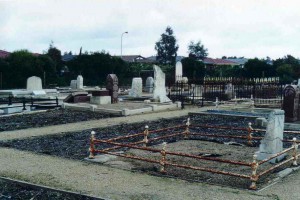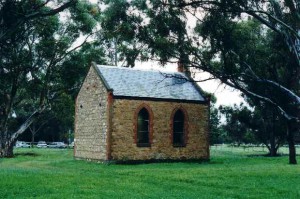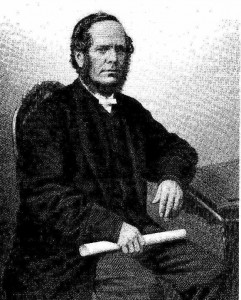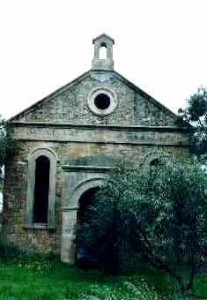A Visit to some of the early sites of Methodism on the Gawler Plains.
On September 1, 2001, I joined 40 other people who had braved inclement weather to visit some of S.A. Methodism’s historic sites on the Gawler Plains (the tract of land between the Little Para and Gawler rivers).
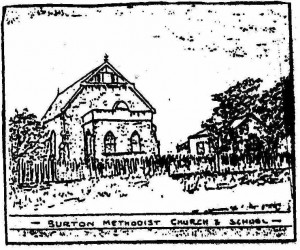 Burton Church and Sunday School
Burton Church and Sunday School
After assembling at the Uniting Church’s Freedom and Community Centre, Paralowie, the cavalcade of hired bus and private cars proceeded to where the Primitive Methodist church stood by the side of the Burton Road.
The church cemetery is all that remains of the original centre. There had once been a substantial church building, erected in 1915 adjacent to the original chapel. A memorial stone now marks the spot and the cemetery is at present being restored as a site of historical significance.
Rev Ted Curnow has reconstructed the history connected with the grave-sites and has published an index and biographical material concerning the 143 people who were interred at the Burton cemetery.
William Diment was a pioneer farmer at Burton. Of church interest is the fact that at 61 years of age, he was the first and only layman to become President of the Primitive Methodist Assembly in South Australia, first in 1883 and again in 1885. Probably his 1883 term of office provided a unique situation in S.A. Methodism. His 29-year-old minister son, William Diment jnr, was the Secretary for the Assembly for that year. It must have been confusing for delegates when matters were referred to ‘William Diment’ to know whether it was father or son who was being named.
As this was my first visit to the old cemetery, it called to mind that two sons of the Secomb family from Two Wells had courted and married two daughters of the Diment family. The younger of the brothers was my great-grandfather. I wondered whether the love-story had begun at one of the Anniversary tea-meetings which were such significant district social events in Primitive Methodism, indeed Methodism generally, in that era.
This old cemetery and church-site is cheek by jowl with a new suburban housing development. That would be something the old pioneers would never have envisaged. On the other hand, the significance of the site probably scarcely impinges, if at all, on the consciousness of these latter-day residents.
On to Sturton Chapel
The next port of call was the site of the Zoar Bible Christian chapel. Again, all that remains of this once thriving congregation is a cemetery. Here we are reminded of the particularly zealous ministry of Samuel Keen, after his arrival on the Gawler Plains in 1853. He diligently sought out the settlers, organised them into groups for worship and urged them to build a chapel as soon as possible. The result was, in Derek Whitelock’s phrase, the countryside “speckled with little chapels”. Keen had a penchant for giving the chapels under his ministry biblical names. In Isaiah 15:5 Zoar is named as “a place of refuge”. In his 1857 report to the Bible Christian Missionary Society in England, Samuel Keen wrote of those converted at Zoar during the past year as “twenty who escaped thither for their life”.
Much of the original farmland in this area, once known as Peachy Belt, has been taken over by the Weapons Research Establishment and Edinburgh Airbase. The Jeffries family, originally from Canada, erected a small chapel on their property known as ‘Sturton’. This chapel was used by the Jeffries family and neighbours, but it always remained a small congregation.
This very small, very plain chapel still stands in reasonably good repair, thanks to the restoration work sanctioned by WRE. With restricted access to the area now applying, we had to have formal permission to visit. This was arranged by Mr Laurie Jeffries, a direct descendant of the pioneer family.
The chapel was built and opened in 1856. Regular services ceased in 1892, but the chapel has been used in more recent times for special Jeffries family occasions. As the latest group to attend, we said a prayer and sang the Doxology to add to the worship that had been offered to God on a regular basis more than 100 years ago.
Angle Vale Methodist Church
At Angle Vale the Methodist church was closed in the 1970’s. The original red-brick chapel still stands but the outside walls are now cement-rendered. The building is in good condition and used as a private home.
This was where Samuel Keen began his South Australian ministry in 1853. After a period of services being held in the homes of the people, this chapel was opened in September 1854, and was named Ebenezer. This is another biblical name, mentioned in 1 Samuel 7:12 – ‘Then Samuel took a stone and set up between Mizpah and Jeshanah and called its name Ebenezer, for he said, “Hitherto the Lord has helped us”.’
The setting up of a stone to mark a sacred place was something done in pre-historic times, long before the days of Samuel. It signified that which could not have been easily toppled. Keen was determined the Bible Christian cause would be on the Gawler Plains for a long time.
“Here I raise my Ebenezer:
Hither by Thy help I’m come.”
Methodist Hymnbook, 417.
(Words from a hymn by one of John Wesley’s preachers, Robert Robertson)
Carclew Chapel
With heavy rain about to descend on us, we made our final stop for the afternoon at the ruined Carclew Primitive Methodist church. The first brick building with a three-roomed cottage attached had been built in 1850 on a block given by Jonathon Roberts from the corner of his property, ‘Carclew’, named after the locality where he had lived in Cornwall.
The building we were looking at had been built in 1870 to replace the original chapel. Although much-abused by vandals, the signs of it having been a fine building were still evident. It still proudly displayed the inscription over the remains of its stately entrance porch : PRIMITIVE METHODIST CHURCH 1870.
Although regular services at Carclew ceased in 1919, the trustees kept the building in good repair, hoping it would be needed again. But it was not to be. After the centenary celebrations in 1950, the fittings and furnishings were disposed of, and the building left to the ravages of neglect. Unfortunately this has also been the fate of the little church cemetery adjoining.
Again the personal links came to mind, as I remembered my great-great-grandfather had come with his wife and two small children to farm on leased land in the area in 1851. Eighteen years later, he purchased land near Two Wells. During the Carclew years, my ancestors had come regularly to the very spot where I was standing, to worship in the Primitive Methodist chapel.
With the rain setting in for the rest of the day, our group had no alternative but to remember briefly and leave quickly.
There would have been others present who, like me, found the occasion was almost a pilgrimage in the original Christian sense of the word.
Kevin Secomb
This article is reprinted from the Society’s Newsletter of October 2001.

